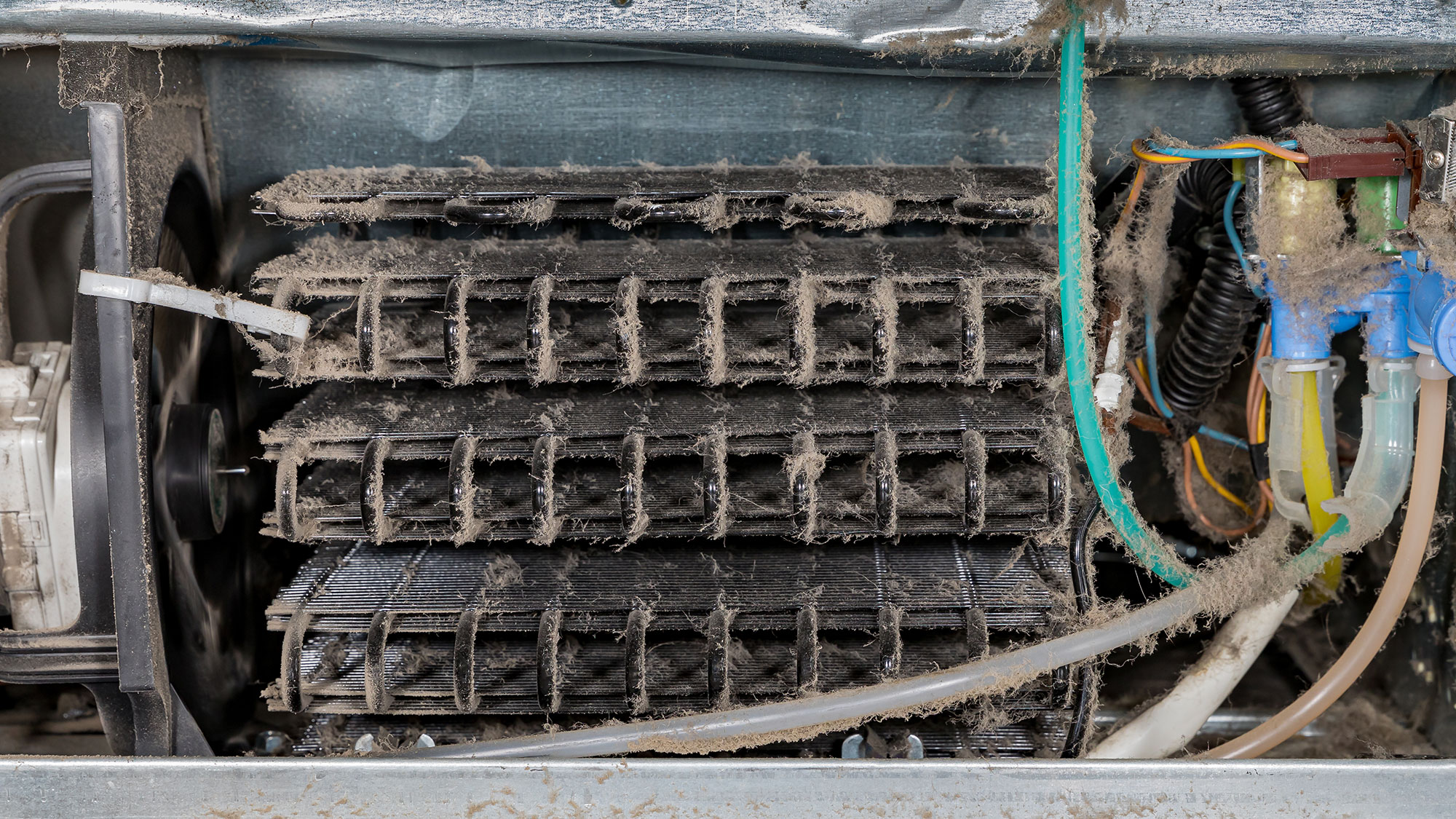Your smelly refrigerator could make your whole kitchen stink — 9 ways to fix it
How to keep your refrigerator smelling fresh and clean

The ultimate job of one of the best refrigerators is to slow down the growth of harmful bacteria and prevent spoilage and wastage of food. However, things can go wrong, and instead of opening a refrigerator to shelves full of fresh-smelling produce, you could find yourself confronted with odors that make you lose your appetite.
There are many reasons why your fridge could stink, with some easier to spot than others. But all the issues are easy to remedy and will ensure you’ll never have a stinky fridge again. Here we've listed nine ways to prevent your fridge from smelling and how to put it right.
1. Check the thermostat

When you’re removing and replacing items in and out of your refrigerator, it’s easy to nudge the thermostat setting. While reducing the temperature won’t cause much of a health issue, apart from a greater build-up of ice, raising the temperature is more cause for concern.
A higher temperature will encourage a build-up of bacteria and the knock-on effect of a bad smell, with food that perishes sooner and goes to waste.
The U.S. Food and Drug Administration (FDA) recommends that your refrigerator temperature should be at 40°F or lower.
Regularly checking the thermostat setting on your refrigerator will take a second or two, but stop food wastage and bad smells before they have a chance to take hold.
One way to easily monitor the temperature of your fridge is to invest in a smart refrigerator, as many will include features where you can check the internal temperature on an app on your phone.
2. Clean neglected compartments

“To prevent unpleasant smells and bacteria growth in your fridge, it’s important to clean neglected areas such as hidden trays,” suggests Nevin Malcok, refrigerator category lead at Hotpoint. “Be sure to do a thorough sweep of your fridge for any removable compartments that could be overlooked and clean up spills immediately using a damp cloth.”
Sign up to get the BEST of Tom's Guide direct to your inbox.
Get instant access to breaking news, the hottest reviews, great deals and helpful tips.
I know from personal experience that those removable compartments can be easily forgotten, and when you displace them, you’re confronted with a grim sight of spilt milk and more. The main culprits in my refrigerator are the removable shelves in the refrigerator door, which I use to store milk, fruit juices, and bottled sauces.
3. Declutter your fridge

While we’re all busy decluttering our kitchen cabinets, we shouldn’t forget about the fridge. Although items are removed and consumed daily, many can lurk unchecked for months.
Check through your refrigerator regularly for items that are out of date and for those that are close to expiry. You can then throw them out or make a note to use them up before they expire. This will avoid unnecessary items being in your fridge, reduce bad smells, and prevent wastage.
4. Wipe down regularly

To keep my refrigerator clean, I wipe it down before every weekly shop to keep it smelling fresh. It’s far easier to clean it before restocking than to clean it while it’s full to the brim. A clean dishcloth rinsed in hot water and washing detergent will do the job just fine.
You can also use this time to check expired food items and compost any salad in the crisper that’s gone past its best.
5. Go deep

Aside from giving your refrigerator a regular wipe-over, Malcok says it will need a deep clean. “Every once in a while, households should give their fridges a deep clean by wiping down each shelf with a food-safe fridge cleaner.”
It’s also worth removing the shelving completely and cleaning the shelf grooves inside the refrigerator. But what about those hard-to-reach nooks and crannies? I’m a big fan of using toothbrushes to clean away grime in awkward places.
You could try Lysol’s Antibacterial Pro Kitchen Spray Cleaner and Degreaser, $3 at Amazon, or for a fragrant scent, try Mrs Meyer’s Clean Day All-Purpose Cleaner Spray in Basil, $4 at Amazon.
6. Neutralize bad smells

Apart from keeping your refrigerator clean, it’s worth neutralizing any odors. Malcok suggests a cheap method to keep your fridge smelling fresh: “Keep an open container of baking soda in the fridge to absorb smells — if the smell persists, pour a full box of baking soda onto a baking sheet and leave overnight.”
Alternatively, you could try an air purifier, such as Vitesy’s Shelfy, which is designed to slow down the ripening process of food by removing bacteria, microorganisms and odor from your refrigerator.
Purriko Refrigerator Deodorizer: $24 @ Amazon
This fridge deodorizer absorbs and decomposes harmful gas odors at source, maintaining a fresh odorless fridge, keeping food fresh for longer. No power supply is needed to run this deodorizer which has an lifespan up to 10 years.
7. Check the condenser coils

While we’ve looked at ways to keep your refrigerator clean inside, one exterior element will make an impact. “Don’t forget to vacuum or clean the coils on the back of the fridge,” says Malcok. “It will help the fridge maintain the right temperature without using excess energy.”
The condenser coils can be cleaned using the brush attachment on a vacuum, but before doing so, be sure to unplug the fridge and check your manufacturer’s guidelines for any further instructions. A microfiber cloth can then be used to remove any remaining dirt.
As a general rule, Big Lake Appliance Service recommends cleaning the coils on your fridge once or twice a year.
8. Clean the refrigerator tray

If you’ve tried all of the above and still can’t fathom why your refrigerator is smelly, it could be worth checking the drip pan at the back of your fridge.
Anything that leaks from inside your fridge runs through a pipe into the tray. Depending on your fridge, you should be able to detach the pipe and remove the drip pan or wipe it clean. However, before doing so, turn off the appliance's power sand consult your manual to ensure that you're not going against brand-specific guidance.
9. Seal the deal

The seal, or gasket, surrounding the door, is designed to form an airtight seal to lock in cold air and keep warm air out. However, if it is not cleaned regularly the seal can become a breeding ground for mold and mildew, causing health issues and an unpleasant smell.
One of the easiest ways to remove mold from a fridge door seal is with a mix of warm water and baking soda, which once applied should be wiped dry with a clean cloth. Vinegar can also be used as a disinfectant, sprayed onto the seal and left for 10 minutes before rinsing with clean water, leaving the gasket to dry before closing the door.
More from Tom's Guide

Camilla Sharman has worked in publishing and marketing for over 30 years and has covered a wide range of sectors within the business and consumer industries both as a feature, content, and freelance writer.
As a business journalist, Camilla has researched articles for many different sectors from the jewellery industry to finance and tech, charities, and the arts. Whatever she’s covered, she enjoys delving deep and learning the ins and out of different topics, then conveying her research within engaging content that informs the reader. In her spare time, when she’s not in her kitchen experimenting with a new recipe, you’ll find her keeping fit at the gym. In the pool, stretching at a yoga class, or on a spin bike, exercise is her escape time. She also loves the great outdoors and if she’s not pottering about in her garden, she’ll be jumping on her bike for a gentle cycle ride.

